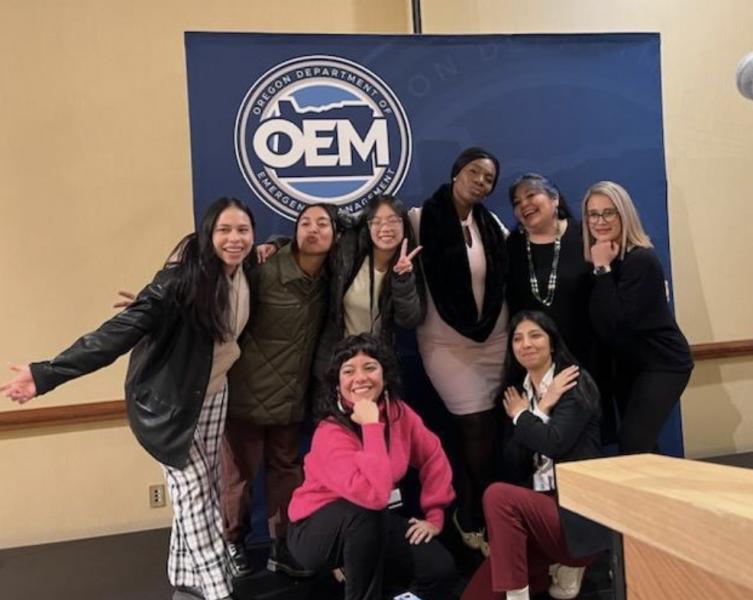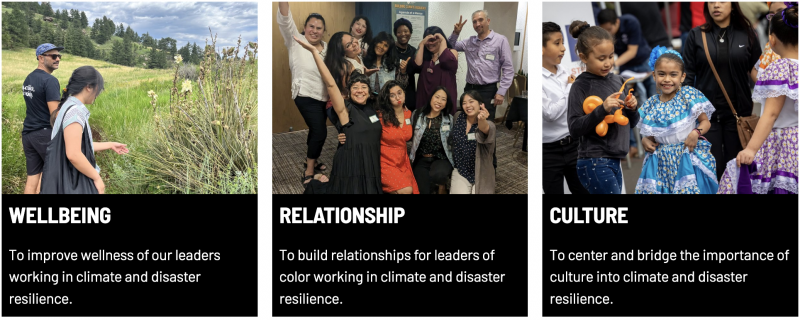Healing as a component of resilience
Michele A Pinkham is no stranger to environmental hazards. She was in high school when Mount St. Helens erupted in 1980 and buried her home in ash. “We had to wear masks and were stranded in our homes for a week. It was not safe to go outside. It was like we were in an apocalypse,” she recounts.
Over the next four decades, Michele has watched and dealt with the environmental impacts of climate change in Oregon. Reduced snowpack, drier summers, and more frequent and damaging wildfires are some of the impacts of climate change documented in the Sixth Oregon climate assessment.
In 2020, Oregon's wildfire season resulted in devastating losses: more than 100,000 acres burned, 40,000 people were evacuated, 500,000 people were warned that they might need to evacuate, and thousands of homes were destroyed. As one response to the devastation, local groups partnered to establish the Disaster Resilience Learning Network (DRLN). Their goal was to bring together culturally specific community-based organizations (CBOs) that could help those who are disproportionately impacted by disasters, especially Latinx and Tribal nations of the Pacific Northwest. The network's plan was based on a model that brought social resilience and trauma-informed care together in a way that was culturally grounded and centered on healing. Recognizing that resiliency does not end at strengthening infrastructure and protecting natural resources, the DRLN seeks to nurture relationship building, center cultural ways of healing, and reimagine disaster response strategies. The network encompassed partners from the Oregon Health Authority, Trauma Informed Oregon, and United Way of the Columbia Willamette.
Storytelling
Michele, who identifies as Two-Spirit and a member of the nimiipuu (also known as the Nez Perce Tribe), is the Development and Community Engagement Director at the Native American Rehabilitation Association of the Northwest, Inc. (NARA NW). One day she was invited to join the Disaster Resilience Learning Network to collaborate on delivering resources and messaging to underserved, marginalized communities after the wildfires. The invitation came with a request: bring a special object or photo to the first meeting. Michele brought a photo of her grandmother dressed in regalia perched on her horse. The picture illustrated how her grandmother taught young Michele how to travel with the seasons. In that first meeting, Michele heard many meaningful stories.
Storytelling is a common healing method that naturally arises during DRLN meetings. “It’s something that has always expanded my scope. Growing up in my culture, the handing down of oral traditions is how I learned to listen. These days, I hear from communities how climate disasters affect them in ways I never would think of. For example, how wildfires exacerbate migrants and seasonal workers’ living conditions and force them to move,” Michele shared. Michele uses stories from the DRLN to create outreach strategies she can use when she transitions back to NARA NW. One example from a recent DRLN workshop focused on preparedness and how everyday objects can be used during an emergency response. She took these lessons and integrated them into a weekly dinner held every Tuesday for Pineewas elders at the community center, showing them how to use Ziplock bags to store important documents and how permanent markers can be used to identify people and their belongings in cases of an evacuation.
Sharing the Network's Model
In addition to the power of storytelling, Michele also feels empowered by the network because “people have actually been listening.” Recently, the DRLN had been invited to speak at the Oregon Prepared conference in 2023. This conference took place during winter and due to poor weather conditions, the conference had to end a day early. This happened to be the day which the DRLN was scheduled to present. As the only Black, Indigenous, People of Color (BIPOC) panel, the members convinced the conference to let them present during the last session before dismissal. The panel presentation went well and the session evaluation showed a wealth of positive feedback. “As a network of people who were never seen or heard, we made sure we were heard that day,” Michele says proudly.
Evolving the Network
The DRLN has grown since its inception in 2021: it currently consists of 21 community-based organizations with 32 active representatives. Initially, the first cohort explored personal and collective power with the intention to create systemic shifts rooted in wholeness and relationships. After surveying members of the network, they developed seven learning circles for the curriculum:
- Introduction and Community Building
- Personal and Community Wellness and Healing
- Climate Health and Disasters
- THRIVE Model (3) and Grant Introductions
- Adverse Community Experiences and Disaster Resilience
- Storytelling and Community-Public Health Partnerships
- Linking Dialogue with the Public Sector
After an evaluation of the pilot, members transitioned from the planning circles into three workgroups:
- Membership and Infrastructure
- Disaster Preparedness and Inclusive Messaging
- Wellness and Education
While the DRLN continues to grow, it remains true to the core mission: to create a supportive space for reflection, co-learning, and collective healing. Michele sees the DRLN as something that is here to stay as the world is always evolving.
Appreciating peace
Out of all the groups she is involved in, Michele chooses to practice her beadwork at DRLN gatherings, indicating that she is “at peace in my heart” at these events. She relates, “It’s a good time for me to do beadwork because I’m putting that energy into the work. We cannot bead when we are hurt, grieving, or mad. The people in the DRLN give me strength. It is a place for me to gather and collect peace and re-energize with my family. I look forward to our quarterly meetings because I know my heart will be in a good place.”



